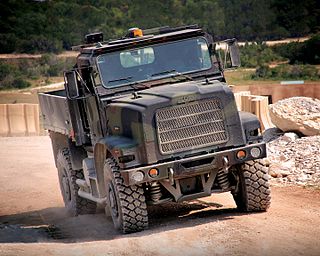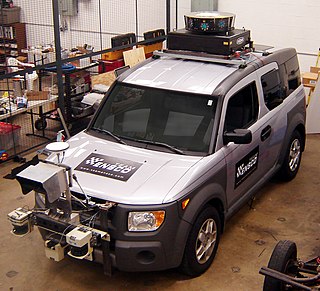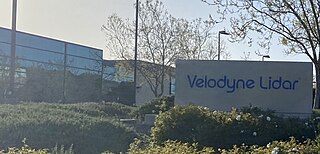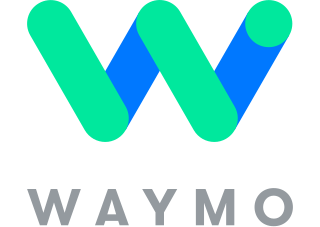Related Research Articles

In transportation, platooning or flocking is a method for driving a group of vehicles together. It is meant to increase the capacity of roads via an automated highway system.

A self-driving car, also known as a autonomous car (AC), driverless car, robotaxi, robotic car or robo-car, is a car that is capable of operating with reduced or no human input. Self-driving cars are responsible for all driving activities, such as perceiving the environment, monitoring important systems, and controlling the vehicle, which includes navigating from origin to destination.
The DARPA Grand Challenge is a prize competition for American autonomous vehicles, funded by the Defense Advanced Research Projects Agency, the most prominent research organization of the United States Department of Defense. Congress has authorized DARPA to award cash prizes to further DARPA's mission to sponsor revolutionary, high-payoff research that bridges the gap between fundamental discoveries and military use. The initial DARPA Grand Challenge in 2004 was created to spur the development of technologies needed to create the first fully autonomous ground vehicles capable of completing a substantial off-road course within a limited time. The third event, the DARPA Urban Challenge in 2007, extended the initial Challenge to autonomous operation in a mock urban environment. The 2012 DARPA Robotics Challenge, focused on autonomous emergency-maintenance robots, and new Challenges are still being conceived. The DARPA Subterranean Challenge was tasked with building robotic teams to autonomously map, navigate, and search subterranean environments. Such teams could be useful in exploring hazardous areas and in search and rescue.

Vehicular automation is the use of technology to assist or replace the operator of a vehicle such as a car, truck, aircraft, rocket, military vehicle, or boat. Assisted vehicles are semi-autonomous, whereas vehicles that can travel without a human operator are autonomous. The degree of autonomy may be subject to various constraints such as conditions. Autonomy is enabled by advanced driver-assistance systems (ADAS) of varying capacity.

TerraMax is the trademark for autonomous/unmanned ground vehicle technology developed by Oshkosh Defense. Primary military uses for the technology are seen as reconnaissance missions and freight transport in high-risk areas without the need of human operators, protecting the soldiers from possible attacks, ambushes or the threat of mines and IEDs. The technology could also be used in civilian settings, such as autonomous snow clearing at airports.
Autonomous logistics describes systems that provide unmanned, autonomous transfer of equipment, baggage, people, information or resources from point-to-point with minimal human intervention. Autonomous logistics is a new area being researched and currently there are few papers on the topic, with even fewer systems developed or deployed. With web enabled cloud software there are companies focused on developing and deploying such systems which will begin coming online in 2018.

The third driverless car competition of the DARPA Grand Challenge was commonly known as the DARPA Urban Challenge. It took place on November 3, 2007 at the site of the now-closed George Air Force Base, in Victorville, California, in the West of the United States. Discovery's Science channel followed a few of the teams and covered the Urban Challenge in its RobocarsArchived 2008-07-30 at the Wayback Machine series.

Velodyne Lidar is a Silicon Valley–based lidar technology company, headquartered in San Jose, California. It was spun off from Velodyne Acoustics in 2016. As of July 2020, the company has had about 300 customers. Velodyne Lidar ships sensors to mobility industry customers for testing and commercial use in autonomous vehicles, advanced driver assistance systems, mapping, robotics, infrastructure and smart city applications. In February 2023, the company merged with Ouster.

Waymo LLC, formerly known as the Google Self-Driving Car Project, is an American autonomous driving technology company headquartered in Mountain View, California. It is a subsidiary of Alphabet Inc.

Experiments have been conducted on self-driving cars since 1939; promising trials took place in the 1950s and work has proceeded since then. The first self-sufficient and truly autonomous cars appeared in the 1980s, with Carnegie Mellon University's Navlab and ALV projects in 1984 and Mercedes-Benz and Bundeswehr University Munich's Eureka Prometheus Project in 1987. In 1988, William L Kelley patented the first modern collision Predicting and Avoidance devices for Moving Vehicles. Then, numerous major companies and research organizations have developed working autonomous vehicles including Mercedes-Benz, General Motors, Continental Automotive Systems, Autoliv Inc., Bosch, Nissan, Toyota, Audi, Volvo, Vislab from University of Parma, Oxford University and Google. In July 2013, Vislab demonstrated BRAiVE, a vehicle that moved autonomously on a mixed traffic route open to public traffic.

A robotaxi, also known as robot taxi, robo-taxi, self-driving taxi or driverless taxi, is an autonomous car operated for a ridesharing company.
Ottomotto LLC, d/b/a Otto, was an American self-driving technology company founded in January 2016 by Lior Ron and Anthony Levandowski.

Anthony Levandowski is a French-American self-driving car engineer. In 2009, Levandowski co-founded Google's self-driving car program, known as Waymo, and was a technical lead until 2016. In 2016, he co-founded and sold Otto, an autonomous trucking company, to Uber Technologies. In 2018, he co-founded the autonomous trucking company Pronto; the first self-driving technology company to complete a cross-country drive in an autonomous vehicle in October 2018. At the 2019 AV Summit hosted by The Information, Levandowski remarked that a fundamental breakthrough in artificial intelligence is needed to move autonomous vehicle technology forward.

Chris Urmson is a Canadian engineer, academic, and entrepreneur known for his work on self-driving car technology. He cofounded Aurora Innovation, a company developing self-driving technology, in 2017 and serves as its CEO. Urmson was instrumental in pioneering and advancing the development of self-driving vehicles since the early 2000s.

A self-driving truck, also known as an autonomous truck or robo-truck, is an application of self-driving technology aiming to create trucks that can operate without human input. Alongside light, medium, and heavy-duty trucks, many companies are developing self-driving technology in semi trucks to automate highway driving in the delivery process.
Aurora Innovation, Inc., doing business as Aurora, is a self-driving vehicle technology company based in Pittsburgh, Pennsylvania. Aurora has developed the Aurora Driver, a computer system that can be integrated into cars for autonomous driving. Aurora was co-founded by Chris Urmson, the former chief technology officer of Google/Alphabet Inc.'s self-driving team, which became known as Waymo, as well as by Sterling Anderson, former head of Tesla Autopilot, and Drew Bagnell, former head of Uber's autonomy and perception team.
Plus is an American autonomous driving technology company based in Santa Clara, California. The company develops Level 4 autonomous driving technology for commercial freight trucks. In 2019, the company completed the first cross-country driverless freight delivery in the U.S. The company's self-driving system began to be used commercially in 2021.
Aeva Technologies, Inc. is a publicly traded American corporation specializing in sensing hardware and perception software, including LiDAR, headquartered in Mountain View, California. Aeva makes sensing and perception tools for vehicular automation, metrology, and industrial automation.
Gatik is an autonomous trucking and delivery company that operates in the United States and Canada. The company creates Level 4 autonomous trucking technology for vehicles making middle mile commercial deliveries.
References
- ↑ TORC Robotics to expand in Blacksburg with room for 20 more employees , The Roanoke Times, Dec 19, 2016
- ↑ , The Informant, June 25, 2021
- ↑ Blacksburg company involved in self-driving vehicles cruises into new home , The Roanoke Times, July 25, 2015
- 1 2 TORC Robotics in Blacksburg was a pioneer in the technology behind driverless cars , Virginia Business, October 30, 2014
- 1 2 TORC Robotics to develop long-range obstacle detection for autonomous vehicle navigation , Telematics Wire, January 18, 2012
- ↑ Marine Corps futurists prototyping modular ground robot , Inside Defense, April 18, 2017
- 1 2 Autonomous Vehicle Developed for Surveying Assault-Zone Runways , Mars Daily, May 11, 2012
- ↑ Remote control system for compact equipment , Pro Contractor Rentals
- ↑ DCD Protected Mobility showcasing unmanned Husky route clearance vehicle , defenceWeb, Sep 15, 2016
- ↑ Automatic , Virginia Tech Magazine, Spring 2012
- ↑ Autonomous Vehicles Complete DARPA Urban Challenge , IEEE Spectrum, Nov 1, 2007
- ↑ About the Blind Driver Challenge , National Federation of the Blind
- ↑ Blind Driver Challenge project wins top awards at National Instruments' NI Week , Virginia Tech College of Engineering
- ↑ Eyes on the Road: TORC Robotics Helps Blind Driver See , Allied Vision, May 18, 2015
- ↑ Blind Man Drives High-Tech Car at Daytona Speedway , Fox News Auto, Jan 31, 2011
- ↑ DARPA Selects Team ViGIR Led by TORC for Robotics Challenge , Unmanned Systems Technology, Oct 22, 2012
- ↑ 2 College of Engineering robotics teams prep for DARPA Robotics Challenge finale , Virginia Tech, June 4, 2015
- ↑ Intelligent Robots Set to Change Combat Landscape , Military.com, Aug 10, 2012
- ↑ TORC delivers remote control solutions for hazardous mining areas , mining-technology.com, Apr 2, 2014
- ↑ Saxton lab Demonstrates Multivehicle Platooning with CAAC , U.S. Department of Transportation, Fall 2015
- ↑ Self-driving car arrives in Seattle after 2,500-mile autonomous cross-country trip , GeekWire, July 14, 2017
- ↑ Car drove 4,300-plus miles autonomously on cross-country trip, ending at Virginia's Executive Mansion , Richmond Times Dispatch, July 26, 2017
- ↑ "Torc Robotics to help build self-driving vehicles for Chinese automaker". Roanoke Times. 4 January 2019. Retrieved 2019-02-07.
- ↑ "Torc Robotics and Transdev are launching autonomous shuttles to deliver people to public transit". TechCrunch. 7 January 2019. Retrieved 2019-02-07.
- ↑ Daimler Trucks agrees to acquire majority stake in Torc Robotics to create technology powerhouse for automated trucks ,Daimler Trucks North America, Retrieved March 29, 2019
- ↑ Self-driving trucks are being tested on public roads in Virginia , CNBC, Sep 10, 2019
- ↑ Daimler and Torc Robotics begin testing automated trucks on public roads in Virginia , Robotics and Automation News, Sep 19, 2019
- ↑ Daimler Trucks tests self-driving vehicles in US Southwest , Washington Post, Sep 3, 2020
- ↑ Torc Robotics to use AWS cloud for self-driving truck fleet , SupplyChain, Feb 17, 2021
- ↑ Daimler Trucks and Torc partner with Luminar on automated trucking , Fleet Owner, Nov 3, 2020
- ↑ Who is leading the self-driving truck race? , iNews, June 7, 2022
- ↑ Self-driving truck company Torc Robotics picks Austin for tech hub , Austin American-Statesman, Jan 7, 2022
- ↑ Global News Roundup: Torc to Open Tech Development Center , Heavy Duty Trucking, May 18, 2022
- ↑ Torc taps Penske to service autonomous trucking test fleet , Fleet Owner, May 9, 2022
- ↑ Richard Bishop (February 28, 2023). "From Photons To Behavior: Torc Robotics Fortifies AI-Based Driving Capability" . Retrieved February 28, 2023.